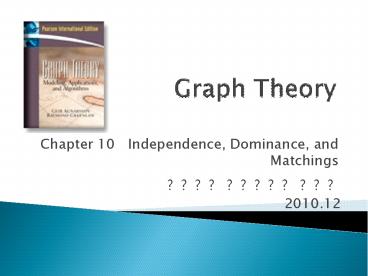Graph Theory - PowerPoint PPT Presentation
Title:
Graph Theory
Description:
Beginning with M and using the Maximum Matching Algorithm for Bipartite graphs to find a maximum matching for G. v13 v12 v11 v10 v9 v8 v1 v2 v3 v4 v5 v6 v7 . – PowerPoint PPT presentation
Number of Views:363
Avg rating:3.0/5.0
Title: Graph Theory
1
Graph Theory
- Chapter 10 Independence, Dominance, and
Matchings
???? ????? ??? 2010.12
2
Contents
- 10.1 Independence of Vertices
- 10.2 Domination of Vertices
- 10.3 Matchings in Graphs
3
10.1 Independence of Vertices
Definition 9.18
Definition 10.1
4
Note 10.3
5
Example 10.4 (Frequency Assignment
Problem)9??????(u1u9),??????????,????????????
u3
u5
u4
u2
u1
G
u6
u7
u8
u9
5?
Observation 10.6 For a graph G, the
independence number a(G) satisfies
.
6
10.2 Domination of Vertices
Definition 10.11
7
Example 10.13 (????police station??)??(u1u9),???
?,police station??????????,?????police station?
u5
u3
u4
u2
u1
G
u6
u7
u8
u9
3?
Observation 10.16 For a graph G, the
domination number g (G) ? a (G).
8
10.3 Matchings in a Graph
Example 1.3 (Job Assignment Problem)Job J1J5,
Applicants A1A7, Job?Applicant?????????????????,
?????????
Jobs
qualified
Applicants
9
Example 10.24 (Weighted Job Assignment
Problem)Job J1J5, Applicants A1A7,
Job?Applicant????????????????????(????????),?????
????????
10
Definition 10.26
perfect matching
not a matching
11
a
b
M ab, cd, ef is a maximum matching M
bc, de is maximal, not maximum.
c
d
e
f
Maximum (??matching???edge?) ? Maximal
(?matching??????????matching)
12
Remark 10.28
Definition 10.30
13
An M-augmenting path P of G
?M
?M
?M
?M
?M
?M
P?????M???M?????,M???????
Theorem 10.32
14
?? Maximum Matchings in Bipartite Graphs
- Algorithm (Maximum Matching Algorithm for
Bipartite graphs)To determine a maximum
matching in a bipartite graph G with V(G)v1,
v2, , vp and an initial matching M1. - 1. i ?1, M ? M1
- 2. If i lt p, then continue otherwise, stop, M
is a maximum matching now. - 3. If vi is matched, then i ? i 1 and return to
Step 2otherwise, v ? vi and Q is initialized to
contain v only. - 4. 4.1 For j 1, 2, , p and j ? i, let
Tree(vj)F. (??vj??alternating tree?)
Also, Tree(vi)T.
15
- 4.2 If Q? , then i ? i 1 and return to step
2 otherwise, delete a vertex x from Q and
continue. - 4.3 4.3.1 Suppose that N(x)y1, y2, ,
yk. Let j ? 1. 4.3.2 If j ? k, then y ? yj
otherwise, return to Step 4.2. - 4.3.3 If Tree(y)T, then j ? j 1 and
return to Step 4.3.2 otherwise,
continue. 4.3.4 If y is incident with a
matched edge yz, then Tree(y)?T,
Tree(z)?T, Parent(y)?x, Parent(z)?y
and add z to Q, j ? j 1, and return to Step
4.3.2. Otherwise, y is a single
vertex (???!) and we continue.
4.3.5 Use array Parent to determine the
alternating v-x path P in the tree.
Let P ? PUxy be the augmenting
path. - 5. Augment M along P to obtain a new matching M.
Let M ? M, i ? i 1 , and return to step 2.
16
Example
i1, x1 is matched.
x1
y1
i2, vx2
x2
y2
x3
x5
x4
x1
x6
x3
y3
x4
y4
y5
x5
x6
y6
???Initial matching M
17
Example (Fig 6.6)
x1
y1
i3, x3 is matched.
x2
y2
i4, x4 is matched.
x3
y3
x4
y4
y5
x5
i12, y6 is matched.
x6
y6
New matching M
M x2y6, x5y4, x1y1, x4y3, x3y2, x6y5 is
maximum.
18
Homework
- Let G be the given bipartite graph. The edges of
a matching M are shown in bold. Beginning with M
and using the Maximum Matching Algorithm for
Bipartite graphs to find a maximum matching for
G.
v1
v2
v3
v4
v5
v6
v10
v13
v12
v11
v9
v8
v7































